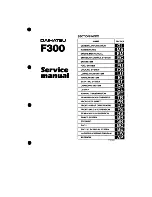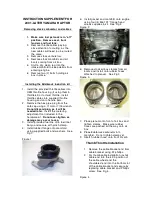
Valve springs
Referring to the criterion data given below, check to be sure that
each spring is in sound condition, free of any evidence of break-
age or weakening. Remember, weakened valve springs can be
the cause of chatter, not to mention the possibility of reducing the
power output due to gas leakage caused by decreased seating
pressure.
Spring squareness:
Use a square and surface plate to check each spring for square-
ness in terms of the clearance between the end of valve spring
and the square. Valve springs found to exhibit a larger clearance
than the limit must be replaced.
Camshaft
A noisy engine or an engine producing not enough power is fre-
quently due to its camshaft excessively worn or bent or bowed. The
wear could occur on its cams and journals.
Camshaft runout:
Hold the camshaft between two center points, with a dial gauge
rigged up to measure its runout. Replace the camshaft if the
amount of runout so measured exceeds the limit.
Cam wear:
Measure the height “a” of each cam. If any of the micrometer
readings taken is down to or less than the limit, replace the cam-
shaft.
6A-24
ENGINE MECHANICAL (F8B ENGINE)
Item
Standard
Limit
Valve spring free
length
48.9 mm
(1.925 in.)
47.6 mm
(1.874 in.)
Valve spring pre-
load
23.6 – 27.6 kg
for 40 mm
(52.0 – 60.8 Ib/1.57 in.)
22.0 kg
for 40 mm
(48.5 Ib/1.57 in.)
Valve spring squareness limit
2.0 mm (0.079 in.)
Camshaft runout limit
0.10 mm (0.0039 in.)
Cam height “a”
Standard
Limit
Intake cam
36.152 mm
36.100 mm
Exhaust cam
36 5
(1.423 in.)
36 00
(1.421 in.)
Pump drive cam
33.300 mm
(1.311 in.)
33.000 mm
(1.299 in.)
















































